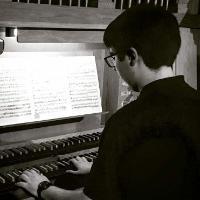All Activity
- Past hour
-
By the way, I have long since done away with the harsh instruments of my composition program's yore. So if people are not listening because they're afraid of having their ears abused by sawtooth waves, you may rest assured that they problem has to a fair extent been corrected. The instruments are still not ideal, but they're much better than they were. How does my program work? Well, it certainly isn't one of those random generators. There is no artistic value whatsoever in randomness. No, my program is 100% deterministic. Anyone who knows what they're doing in is in position of control rather than one of letting the winds blow where they may. Basically, the program is A, a musical instrument and B, a tool for calculating good harmony and counterpoint according to certain esoteric principles that I discovered and about which no else knows anything. I use this program because I need a good instrument like any composer and because the calculations involved in properly controlling harmony and counterpoint are thousands of times too complex to perform without the aid of a tool that automates the process and does so quickly. So what do I do? I first design and input a melody. Then I enter a number, one very easy to choose, for each timestamp that turns the melody note into a full harmony that represents it and which will flow smoothly and coherently into the next harmony. Does my program work? I think it is quite clear that it does. Not perfectly--I am still improving the program--but it's certainly getting there.
- Today
-
This one turned out very nicely. Give it a listen:
-
Making very good progress on the music creation program. Here's counterpoint it generated using a simple melody I input:
-

String Sextet in G-flat major (My best work in my life up to date!)
Uhor replied to Henry Ng Tsz Kiu's topic in Chamber Music
I cannot help not hear the Dvorak in this. - Yesterday
-
PeterthePapercomPoser started following "Turmoil" for Brass Quintet | Kyle Hilton (UncleRed99)
-
UncleRed99 started following "Turmoil" for Brass Quintet | Kyle Hilton (UncleRed99)
-
Turmoil.pdf 25099099.mp3 A short brass quintet piece I wrote, originally just to serve as a sound pack demonstration for Vienna Brass sound library in Muse, that ended up becoming a full score. Thought this sounded pretty cool 🙂
-
PeterthePapercomPoser started following The Sun and the Moon , And then I realised - Large Orchestra + SATB Choir , Dance Of The Moonlit Clouds (Piano solo) and 1 other
-
Debussy orchestration (Footsteps in the Snow)
Alex Weidmann replied to Alex Weidmann's topic in Orchestral and Large Ensemble
Thanks Uhor! I discovered a couple of wrong notes in my interpretation that no one seems have spotted, but will go back and correct them when I have time. -
Congrats! A bit like "If Sibelius had counterpoint chops".
-
Nice, if it were titled "Village Scenes" I'd believe it. Incidentally, there is a very good Bartok piece with that name you might want to check.
-

Op.6 Symphonic Suite from Freyja - Vanadis
Uhor replied to Vladisove's topic in Orchestral and Large Ensemble
Immediate like. Consider adding Canteloube (or very early Berio) to your list if you ever compose a folk song suite or something of the like. -

Debussy orchestration (Footsteps in the Snow)
Uhor replied to Alex Weidmann's topic in Orchestral and Large Ensemble
I really like when the intimate aspect of Debussy is the essential component. No the bloated thing in the recent famous orchestrations just mentioned above. Bravo! -

La Soireé dans Granade by Debussy (Orchestrated)
Uhor replied to danishali903's topic in Orchestral and Large Ensemble
Very colourful and apt. It's a shame the audio quality is bad. -

Jouskas (looking for feedback)
Uhor replied to Fruit hunter's topic in Orchestral and Large Ensemble
I'm a fan of the quiet bits too. For an entire course on how to incorporate both calm and disruptive writing there's Boulez's Notations for Orchestra VII, I highly recommend it. -

And then I realised - Large Orchestra + SATB Choir
Uhor replied to Symphonic's topic in Orchestral and Large Ensemble
I'm enjoying it quite a bit. I hear early John Adams. -
Hi everyone, This is my latest piano composition, dance of the moonlit clouds. I believe it has influences like classical and more modern piano music. I could describe this track as: A night scene with the clouds dancing under the moonlight, carried away by the wind...enjoy! You can listen to it here: Dance Of The Moonlit Clouds I have also added the pdf score to this post. Thank you!
-

bach Fantasia sobre un tema de J. S. Bach
JordiHortal posted a topic in Orchestral and Large Ensemble
I’m excited to share with you what is, quite possibly, the most ambitious and elaborate work I’ve composed so far. As the title suggests, it’s an orchestral piece based on Bach’s Little Fugue in G minor (BWV 578). As an organist, this piece has had a profound impact on me throughout my years of study and has always been a reference point—both in terms of performance and musical analysis. Let me briefly explain a few key aspects of the work: - The first instrument to present the theme is the oboe. This was not a random choice: I wanted to pay tribute to Stokowski’s orchestral version of the fugue, in which the oboe also introduces the main theme. - The second section (bar 16) opens with the chord progression from the end of Bach’s fugue, making the connection even more evident if it wasn’t already. This part showcases a reharmonized version of the main theme, which remains ever-present throughout. Some passages directly quote Bach’s fugue, such as bars 39 to 44, where I’ve preserved the original texture of three or four voices. - The third section (bar 70) brings a strong contrast. After a short bridge that shifts to the major key, I introduce a kind of string quartet based on the opening notes of the original fugue. I like to think of it as a chorale harmonization in the spirit of Bach (though not in his actual style), which eventually leads to a climax in bar 95, where the fugue theme reappears in the major key, accompanied by multiple counter-melodies. - No piece based on Bach would be complete without at least a small reference to a fugue—so I decided to end the work with one. The subject of this final fugue is “original” (in quotation marks because it is inspired by something, but I’ll leave the source as a mystery for now—you’re welcome to try and figure it out!). - From bar 126 onwards, the beginning of Bach’s original fugue returns briefly within my own, setting up a kind of “battle” between the two fugue subjects. In the end, Bach’s fugue emerges victorious, and the piece culminates similarly to Stokowski’s version, with the fugue theme resounding in the low brass and trumpets. The only real change I’ve made is in the final three bars, which conceal (though not very subtly) a musical signature of someone—which again, I’ll leave for you to guess. I truly hope you enjoy listening to the piece as much as I enjoyed composing it. This time, I’d especially love to hear your thoughts and feedback, as I’ve been given the opportunity to premiere it with an orchestra I belong to. I want to make sure everything is perfect—musically, but also in terms of notation and the overall score—before bringing it to the stage. Many thanks for the opportunity! -
A vast improvement over my technique up until this point. A sample:
-
So I've been getting creative again and have spent days working on this, still needs to grow and be a lot more polished but it has been fun so far. Warning: loudness
-
.thumb.png.8b5b433a341551e913a34392660bc95b.png)
Simulation Level
PeterthePapercomPoser replied to PeterthePapercomPoser's topic in Incidental Music and Soundtracks
You should check out this topic I started: Favorite video game music tracks?? You could peruse some of the member's favorite tracks or even share your own favorite VGM tracks from Undertale or Deltrarune!




.thumb.png.f5c7c1a6a554eeeefdce321d089f5901.png)